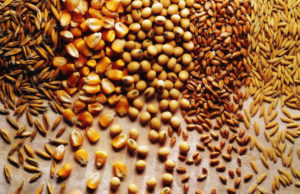 Grain futures were lower on Monday ahead of the U.S. Department of Agricultures weekly crop progress report that is poised to show planting increased in the U.S. Midwest. DTN reported on June 21 that warmer and drier weather in the Midwest will boost crop prospects. Also, the broadly stronger dollar keeps weighing on all commodity prices, including grains.
Grain futures were lower on Monday ahead of the U.S. Department of Agricultures weekly crop progress report that is poised to show planting increased in the U.S. Midwest. DTN reported on June 21 that warmer and drier weather in the Midwest will boost crop prospects. Also, the broadly stronger dollar keeps weighing on all commodity prices, including grains.
Fed’s chairman, Ben Bernanke, said last week the central bank might scale back its monetary stimulus program during the second half of the year and end it by mid-2014. According to Bernanke, Fed’s moves are tied to what happens in the economy and the central bank has no fixed plan, but sentiment points at reducing bond purchases. Bernanke said that if the economy continues to improve in line with Fed’s projections, it would be “appropriate to moderate the monthly pace of purchases later this year”, and end the program as the unemployment rate drops do 7%, which the central bank expects to happen around mid-2014.
The U.S. central bank is projecting the nation’s economy to expand by 2.3% to 2.6% in 2013 and the unemployment rate to shrink to between 6.5% and 6.8% by the end of 2014, which should bring the bond purchasing to an end.
News on the monetary stimulus caused the dollar to surge and erase earlier losses. The dollar index, which tracks the greenback’s performance versus a basket of six major counterparts, pushed almost all commodities down and ended the week 2.21% higher. On Monday, the dollar gauge extended gains, trading at 82.93 at 12:38 GMT, 0.39% higher on the day.
Wheat drops
On the Chicago Mercantile Exchange, wheat futures for September delivery marked a 1.40% daily loss. The grain stood at $6.9513 a bushel, marking a new days low. Daily high stood at $7.0175. Wheat continues its bearish trend as ample global supply is projected.
Increased wheat supply is expected by Australia, Russia and Ukraine’s Black Sea region and Europe. Worldwide wheat output in the 2013-2014 crop year is expected to be 6.1% higher than the preceding period and near the record level of the 2011-2012 season, totaling 695.9 million metric tons of wheat, the USDA said on June 12. Canada is expected to boost its output by 6.6%, Russia by 43% and a 24% jump is expected in Ukraine, which will counter an 8.3% drop in the U.S.
In its weekly crop progress report last week, the USDA said that only 11% of the winter wheat was harvested as of June 16, compared to the preceding week’s 5%. This is well below last year’s 51% and the five-year average of 25%.
Meanwhile, 92% of the nation’s spring wheat was planted up to June 16, compared to 100% in 2012. This is also below the 97% five-year average. Winter wheat condition is worse than the previous season. This year 43% of the crop is of “Very poor” and “Poor” quality, 26% is “Fair” and 31% belongs to the “Good” and “Excellent” categories. As of the same week 2012, 17% of the winter wheat crop was categorized as “Very poor” and “Poor”, 29% “Fair” and 54% had “Good” and “Excellent” qualities.
Corn also falls
Corn lost as much as 1.90% on Monday, trading at $5.8038 a bushel at 12:31 GMT. Corn September futures ranged between days high and low of $5.8625 and $5.7988 a bushel respectively.
Luke Mathews, a commodity strategist at Commonwealth Bank of Australia (CBA) said for Bloomberg: “The Midwest is meant to see generally dry conditions but interspersed with enough rain to keep things under a favorable production outlook.”
The USDA said U.S. corn stockpiles before the 2014 harvest will total 1.949 billion bushels, well above market projections of 1.829 billion. This fall’s U.S. harvest will also exceed the 13.82 billion bushels expectations and will total 14.005 billion. The record domestic output will more than double inventories before the 2014 harvest, said the agency.
In its crop progress report on Monday last week, the USDA said that 92% of the nation’s corn crop emerged as of June 16, compared to 85% in the previous week. However, this is lower than the comparable week last year’s complete emerge of the crop and the five-year average of 97%.
The grain’s condition is comparable to last year’s with differences of a minor 1% in the “Poor” and “Excellent categories”. During the week ending June 16, corn of “Very poor” and “Poor” quality stood at 8%, “Fair” was 28% and 64% of the crop fell in the “Good” and “Excellent” sections.
Soybeans drop as well
Soybeans also marked daily losses, trading at $14.0375 a bushel, down 0.67% on the day. The oilseed ranged between days high and low at $14.0938 and $14.0275 respectively. Soybeans are still pressured as reduced demand outlook from China weighs on prices. The Asian country had its economy growth forecast trimmed once again by Goldman Sachs to 7.4%, down from 7.8%.
Last week, the USDA weekly crop report showed soybeans planting fell behind last year’s pace and stood at 85% as of June 16, up from the preceding week’s 71%. However, this is well below last year’s 98% and the five-year average of 91%.
Also, soybeans emerged stood at 66% last week, compared to 48% in the preceding period. That is below the 2012 94% figure and the five-year average of 80%.
Market players are now looking into this weeks USDA crop progress report, scheduled for later today. Grains are expected to keep their bearish trend if the agency reports the expected news of improved planting due to the favorable conditions.





